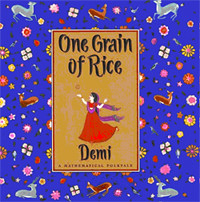3 Folktales for National Folktale Month
Three Favorite Folktales
It’s National Folktale Month! And I’m digging into the vaults to share three of my favorites, all starring leading ladies. For me, folktales are food for the soul. And when packaged into a picture book, also provide a feast for the eyes. They are an important part of your child’s literary diet, so next time you go to the library don’t forget the folktales!
The Woman Who Outshone The Sun
 The Woman Who Outshone The Sun is a bi-lingual story about Lucia Zenteno, a beautiful and seemingly magical woman who, accompanied by an entourage of butterflies, arrives in a small Mexican village. Her beauty is so sublime, the river, fishes, otters, and birds fall in love with her. But the people are frightened by her special powers and eventually drive her from the village. The river leaves with Lucia, and the village is plagued with drought. Awakening to their mistake the people search for Lucia, walking for days to an iguana cave where she has taken refuge. At first no one says a word, but then two children make the first move and offer an apology. Lucia sees the people are truly sorry and, feeling compassion, agrees to return to the village and comb the river from her hair. Her parting words to the village people are about kindness and tolerance, even for those who seem different. The last image shows Lucia as a spiritual entity, embracing the village in a gesture of protection, her long black hair full of stars.
The Woman Who Outshone The Sun is a bi-lingual story about Lucia Zenteno, a beautiful and seemingly magical woman who, accompanied by an entourage of butterflies, arrives in a small Mexican village. Her beauty is so sublime, the river, fishes, otters, and birds fall in love with her. But the people are frightened by her special powers and eventually drive her from the village. The river leaves with Lucia, and the village is plagued with drought. Awakening to their mistake the people search for Lucia, walking for days to an iguana cave where she has taken refuge. At first no one says a word, but then two children make the first move and offer an apology. Lucia sees the people are truly sorry and, feeling compassion, agrees to return to the village and comb the river from her hair. Her parting words to the village people are about kindness and tolerance, even for those who seem different. The last image shows Lucia as a spiritual entity, embracing the village in a gesture of protection, her long black hair full of stars.
This little-known picture book is a real gem. The story is told in crisp, straightforward language, and the illustrations are striking in their play of color and line. Bits of whimsy, such as a girl riding a hummingbird and feet poking out of treetops, hover around the central images and add to the folkloric feel of the story. This particular version of the tale is inspired by a poem written by Alejandro Cruz Martinez, a young Zapotec Indian who collected the oral traditions of his people, including this one about Lucia Zenteno. He was killed in 1987 while organizing the Zapotecs to regain their lost water rights. The book delivers a valuable environmental message, and given the state of our current climate crisis, it seems imperative that folktales like this one are kept alive.
The Woman Who Outshone The Sun from a poem by Alejandro Cruz Martinez, written by Rosalma Zubizarreta, Harriet Rohmer, and David Schecter, illustrated by Fernando Olivera. Published by Children’s Book Press, Sam Francisco, 1991. ISBN: 0-89239-101-4
One Grain of Rice
 One Grain of Rice written and illustrated by Demi is a mathematical folktale from India. It opens with a self-described fair and decent Raja, who decides to collect most of the rice from each farmer’s harvest for safe keeping in the royal storehouse. The Raja promises the rice will be used in times of famine so no one will go hungry. For several years the rice harvest is bountiful, and the people give most of their rice to the Raja, with barely enough left for themselves. Then one year the harvest fails and the people have no rice to eat and no rice to give the Raja. Famine and hunger spread throughout the land. But the Raja refuses to honor his promise, and instead covets all of the people’s rice for himself. One day a girl named Rani does a good deed for the Raja and he offers her a reward. She asks for just one grain of rice, doubled each day for 30 days. The Raja, thinking it is a modest request, agrees. But as the story unfolds the Raja, and likely the reader too, is surprised by how fast Rani’s rice is accumulating. When 256 elephants bearing bundles of rice march across a four-page foldout, readers will cheer Rani’s resourcefulness. For by the end of the 30 days, Rani has turned one grain of rice into one billion grains of rice, enough to feed all the hungry people in her land.
One Grain of Rice written and illustrated by Demi is a mathematical folktale from India. It opens with a self-described fair and decent Raja, who decides to collect most of the rice from each farmer’s harvest for safe keeping in the royal storehouse. The Raja promises the rice will be used in times of famine so no one will go hungry. For several years the rice harvest is bountiful, and the people give most of their rice to the Raja, with barely enough left for themselves. Then one year the harvest fails and the people have no rice to eat and no rice to give the Raja. Famine and hunger spread throughout the land. But the Raja refuses to honor his promise, and instead covets all of the people’s rice for himself. One day a girl named Rani does a good deed for the Raja and he offers her a reward. She asks for just one grain of rice, doubled each day for 30 days. The Raja, thinking it is a modest request, agrees. But as the story unfolds the Raja, and likely the reader too, is surprised by how fast Rani’s rice is accumulating. When 256 elephants bearing bundles of rice march across a four-page foldout, readers will cheer Rani’s resourcefulness. For by the end of the 30 days, Rani has turned one grain of rice into one billion grains of rice, enough to feed all the hungry people in her land.
Demi has published more than 100 books, and is well known for her multi-cultural folktales, legends, and picture book biographies. The delicate illustrations in this work were inspired by traditional Indian miniature paintings of the 16th and 17th centuries, and were created with Chinese brushes, paint, ink, and Demi’s distinctive use of gold leaf, which adds a shimmering quality to the drawings. A table in the back gives a visual interpretation of how Rani, with her understanding of multiples, outsmarted the greedy Raja. The story has a great moral, a courageous heroine, and an entertaining math lesson all bundled into a 40-page picture book: One Grain of Rice packs a lot of nutritive punch.
One Grain of Rice: A Mathematical Folktale written and illustrated by Demi. Published by Scholastic Press, New York, 1997. ISBN: 0-590-93998-X
How The Amazon Queen Fought The Prince of Egypt
 How The Amazon Queen Fought The Prince of Egypt is an ancient Egyptian folktale peeled from a longer work called “Egyptians and Amazons.” Found on a badly tattered papyrus scroll, which is now housed in a museum in Austria, the story was only partly preserved. Author/illustrator Tamara Bower attests that she has stayed true to the original, and there is no denying her extensively researched picture book presents a captivating slice of ancient Egyptian art and culture. The folktale opens long ago in Khor, an area encompassing Syria and Assyria, where the Amazons lived, free of men, in a Land of Women. One day scouts alert the Amazon Queen, Serpot, that an Egyptian army and their Assyrian allies are approaching. Serpot asks her sister Ashteshyt to disguise herself as a man and spy on their camp. Because no one knows she is a woman Ashteshyt is able to infiltrate much of the camp’s inner workings. Readers will enjoy pouring over the illustrated scroll, which shows her spying on the Egyptian army in various scenes.
How The Amazon Queen Fought The Prince of Egypt is an ancient Egyptian folktale peeled from a longer work called “Egyptians and Amazons.” Found on a badly tattered papyrus scroll, which is now housed in a museum in Austria, the story was only partly preserved. Author/illustrator Tamara Bower attests that she has stayed true to the original, and there is no denying her extensively researched picture book presents a captivating slice of ancient Egyptian art and culture. The folktale opens long ago in Khor, an area encompassing Syria and Assyria, where the Amazons lived, free of men, in a Land of Women. One day scouts alert the Amazon Queen, Serpot, that an Egyptian army and their Assyrian allies are approaching. Serpot asks her sister Ashteshyt to disguise herself as a man and spy on their camp. Because no one knows she is a woman Ashteshyt is able to infiltrate much of the camp’s inner workings. Readers will enjoy pouring over the illustrated scroll, which shows her spying on the Egyptian army in various scenes.
Queen Serpot decides to fight the Egyptians and gathers an army of women. With the goddess Isis and god Osiris leading them, the Amazon women fight fiercely, each woman fighting like “ten men.” The army drop their weapons and retreat. The Egyptian Prince Pedikhons is enraged, and challenges the queen to single combat. They rush “at each other like vultures” and attack “like panthers,” matching each other in skill and artistry. They fight through the day and as the sun sets, Prince Pedikhons, who “never believed woman could conquer man,” puts down his sword and admits that Queen Serpot is his equal.
This rare piece of folkloric history is intriguing on its own, but when placed in the context of Bower’s detailed illustrations, the full effect is mesmerizing. The Egyptian and Assyrian style paintings, rendered in watercolor and gouache on paper, fill the pages. Hieroglyphic translations of key phrases complement most of the storyline, and symbolic imagery is embedded throughout, all of which the artist explains in her endnotes. The book as a whole is a remarkable journey into the past, and offers a powerful commentary on equality of the sexes we can bring with us into the present.
How the Amazon Queen Fought The Prince Of Egypt written and illustrated by Tamara Bower. Published by Atheneum Books for Young Readers, New York, 2005. ISBN: 0-689-84434-4
ABOUT THE AUTHOR
Cheli has been involved with creative arts and education for most of her life, and has taught many subjects from art and books to yoga and zoology. But she has a special fondness for kid’s books, and has worked in the field for more than 20 years. She is a freelance writer and regular contributor to Valley Kids and teaches a course for adults in “Writing for Children.” She writes from Colrain, where she lives with her musician-husband, three children, and shelves full of kid’s books.
 Hilltown Families
Hilltown Families 






























